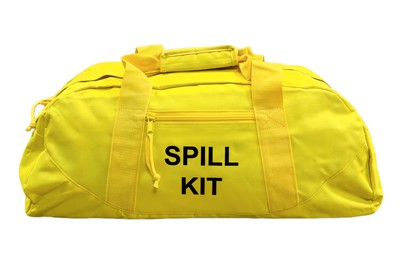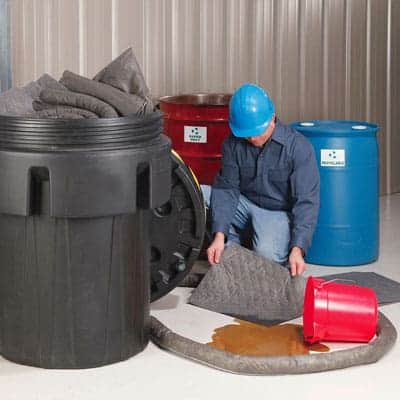In any industrial or commercial setting, spills are a fact of life. Whether it’s oil, chemicals, or other hazardous materials, accidents happen—often when you least expect them. But the real danger lies not just in the spill itself, but in how your workplace handles it.
That’s where OSHA compliance and spill kit preparedness come into play.
The Occupational Safety and Health Administration (OSHA) mandates that employers maintain safe workplaces and implement procedures to respond to hazardous material spills. Failing to comply with these rules can lead to serious consequences—ranging from employee injuries to steep financial penalties.
In this comprehensive guide, we’ll walk you through the essentials of OSHA spill kit requirements, what types of spill kits your business might need, how they align with EPA regulations, and how you can easily meet these standards with help from AbsorbentsOnline.com.
Why OSHA Spill Kit Compliance Is Crucial
The need for proper spill response equipment goes beyond good housekeeping. According to OSHA’s General Duty Clause, employers are legally obligated to provide a workplace “free from recognized hazards that are likely to cause death or serious physical harm.”
When hazardous liquids are stored, transported, or used on-site, they present very real risks to:
- Employee health and safety
- Environmental quality
- Workplace equipment
- Facility operations
Non-compliance with OSHA regulations related to spills can result in costly fines, damaged reputations, and even criminal liability in extreme cases. That’s why ensuring your facility has the right spill kits—and that your staff knows how to use them—is not optional. It’s a vital part of responsible business operations.

Which OSHA Standards Address Spill Kits?
While OSHA doesn’t publish a single document listing specific spill kit requirements, several of its regulations directly apply to spill preparedness and cleanup. Understanding these standards is key to maintaining compliance:
1. 29 CFR 1910.120 (HAZWOPER)
Covers emergency response operations involving hazardous substances. It requires employers to develop spill response plans, provide PPE, and train employees.
2. 29 CFR 1910.1200 (Hazard Communication Standard)
Requires proper labeling, material safety data sheets (SDS), and worker training related to hazardous materials. This implies the need for proper containment and cleanup tools.
3. General Duty Clause (Section 5(a)(1))
Mandates that employers provide a safe workplace, which includes appropriate emergency response tools like spill kits.
4. 29 CFR 1910.1030 (Bloodborne Pathogens Standard)
If your workplace handles biohazardous spills, this regulation requires special cleanup kits and procedures.
Spill Kit Essentials: What Must Be Included?
An OSHA-compliant spill kit isn’t just a box with rags and gloves. It must be thoughtfully stocked to handle the specific materials used at your facility. The type and size of the kit should reflect the volume and nature of potential spills.
Core Components of a Spill Kit:
- Absorbents: Pads, pillows, and socks to contain and soak up liquids
- Personal Protective Equipment (PPE): Gloves, goggles, coveralls, and shoe covers to protect workers
- Disposal Materials: Bags and twist ties to safely contain and discard used absorbents
- Warning Labels: Signage and labeling materials to identify spill zones and hazardous waste
- Instructions & SDS Access: Clear guidance on how to handle the spilled substance and access to safety documentation
Types of Spill Kits and Their Uses
Different industries handle different materials—and that means one type of spill kit won’t work for every scenario. Here’s a breakdown of the most common spill kits and when to use them:
1. Universal Spill Kits
These kits are designed to absorb non-aggressive liquids such as water-based fluids, coolants, and general-purpose chemicals. Ideal for manufacturing, maintenance shops, and warehouses.
2. Oil-Only Spill Kits
Made with hydrophobic materials that repel water and attract hydrocarbons, these kits are essential in marine environments, oil and gas facilities, or any setting where petroleum products are handled.
3. Hazmat Spill Kits
Engineered for aggressive chemicals like acids, solvents, or caustics. Hazmat kits are color-coded (usually yellow) and built to neutralize and contain dangerous chemical reactions.
4. Battery Acid Spill Kits
Specifically designed to neutralize and clean up sulfuric acid spills from batteries, these are vital for facilities with forklifts or backup power systems.
5. Biohazard Spill Kits
These are required for cleanup of blood and other potentially infectious materials (OPIM), particularly in healthcare or laboratory settings.

Spill Kit Placement and Accessibility
Having the right kits is only half the equation. OSHA emphasizes the importance of quick access to emergency equipment. Here are best practices for spill kit placement:
- Proximity Matters: Kits should be placed near high-risk zones such as loading docks, chemical storage areas, or fluid transfer stations.
- Signage is Key: Clear, visible labels help workers locate spill kits quickly.
- Avoid Clutter: Spill kits should never be blocked by other items or locked away in inaccessible locations.
- Wall-Mounted Options: These can improve visibility and accessibility in high-traffic areas.
Training and Maintenance Requirements
OSHA not only requires the right tools but also mandates that employees know how to use them. That means:
- Regular training sessions on spill response protocols
- Mock drills to simulate different spill scenarios
- Monthly inspections of all spill kits to ensure they’re fully stocked
- Restocking procedures for used or expired components
Training isn’t a one-time event. OSHA expects ongoing education to keep your workforce prepared for emergencies.
Don’t Forget EPA Regulations
Beyond OSHA, the Environmental Protection Agency (EPA) imposes its own standards for spill prevention and containment—especially for facilities near water sources.
Under the Clean Water Act and Spill Prevention, Control, and Countermeasure (SPCC) rule, the EPA requires businesses to have a spill response plan and proper containment systems in place.
This includes:
- Spill pallets and secondary containment for drums and IBCs
- Stormwater protection products like drain covers and berms
- Mobile spill containment units for transportation
EPA violations can result in environmental damage and substantial fines, so it’s wise to choose spill solutions that satisfy both OSHA and EPA requirements.
Choosing the Right Spill Containment Supplier
When it comes to staying compliant, your choice of supplier makes a big difference. You want a partner that not only sells high-quality products but also understands the regulations behind them.
That’s where AbsorbentsOnline.com stands out.
With over two decades in the business, AbsorbentsOnline offers:
- A huge selection of OSHA- and EPA-compliant spill kits
- Specialized products like lab spill kits, truck spill kits, and portable response bags
- Affordable pricing with bulk and custom order options
- Expert customer support to help you choose the right solution
- Fast, reliable shipping to keep your workplace ready
Whether you’re a small auto shop or a national manufacturer, they have the products and know-how to meet your unique needs.
Industries That Need Spill Kits the Most
While every workplace should have some form of spill response plan, certain industries are more prone to hazardous spills than others. These include:
- Manufacturing
- Oil & Gas
- Logistics & Transportation
- Automotive Maintenance
- Construction
- Laboratories
- Utilities
- Marine & Ports
If your business falls into any of these categories, OSHA is almost certainly expecting you to have a spill response system in place.
Final Thoughts: Make Spill Compliance a Priority
Spills are inevitable. But the damage they cause doesn’t have to be. With the right spill kits, training, and procedures, your business can minimize risk, protect your employees, and stay on the right side of OSHA and EPA regulations.
Remember: compliance isn’t just a checklist—it’s a mindset. It shows that your company takes safety and responsibility seriously.
Shop Now for Spill Kit Compliance
Is your workplace truly prepared for a spill emergency?
Visit AbsorbentsOnline.com to explore our full range of OSHA-compliant spill kits, absorbents, and containment solutions. From universal kits to specialty chemical spill response gear, we’ve got everything you need to stay safe, compliant, and confident.
Don’t wait for a spill to take action—be proactive. Shop now and safeguard your business with the best in spill containment.